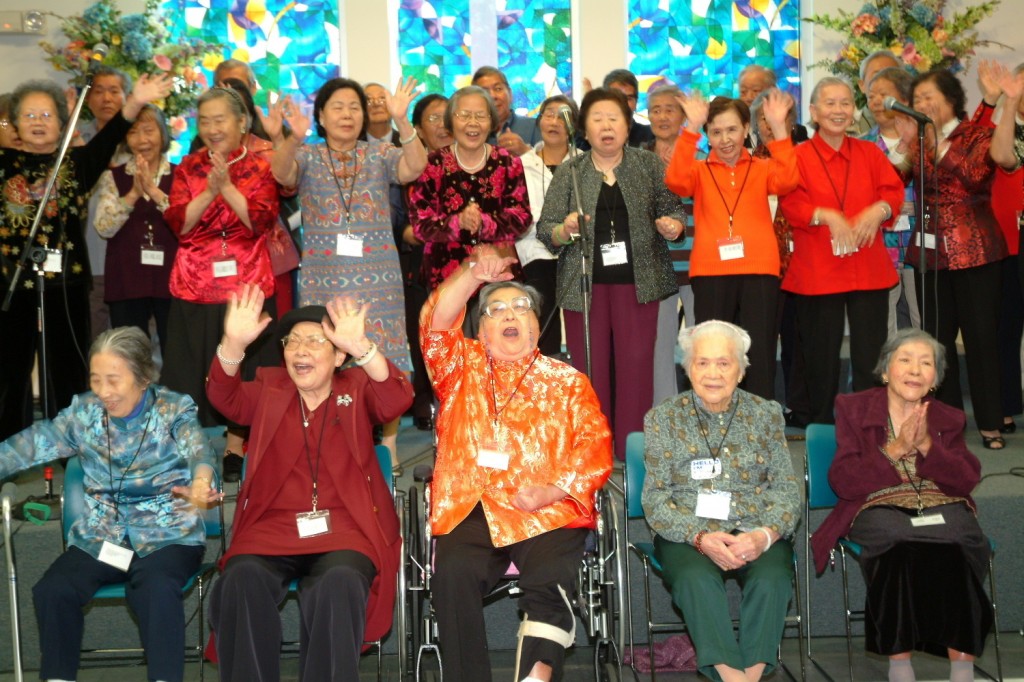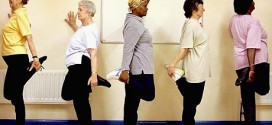By Jenny Chen
In 1976 So Ying Chan and her husband came to the United States to help take care of her grandchildren. Her son, Michael Man, worked as the accounting manager at the National Education Association. Everything was going well. Then, in 1992, Chan’s husband passed away and Chan’s own health began deteriorating.
When Chan hit 83, she developed Alzheimer’s disease and became increasingly forgetful. During the day, when both Man and his wife were at work, Chan would wander onto the streets and get lost. Man would have to call the police to find her and bring her back home. Other days, Chan would be cooking something and wander off forgetting that she had left the stove on.
Whether developing a brain disease like Alzheimer’s or emotional decline like depression, older Asians in the United States, many who immigrated here later in life, face a range of barriers to getting help. But programs are emerging around the country to address their need for culturally appropriate care.
‘A Danger to Herself’
Alarmed that his mother “was becoming a danger to herself,” Man told me later, “We couldn’t afford to take any risks.” Eventually, he and his wife decided that his mother would be safer in a nursing home and brought Chan to a nursing home, which was covered under the Medicaid program for those with low-incomes.
Not many elderly relish the idea of being placed in a nursing home, but for Asian American families like Man’s, the idea of a nursing home is even more difficult to swallow. It is traditional in Asian families for the older generation to live with their kids until they die. For a child to fail in this responsibility is considered the ultimate betrayal of the Confucian notion of filial piety.
Furthermore, Chan’s experience at the nursing home was less than pleasant. She didn’t understand any of the language and wasn’t able to participate in any of the activities. When Man asked the staff to help his mother take a shower he remembers them saying, “Are you kidding?”
Man said that Chan was not used to the food and didn’t eat very much. When Susan Wong visited her six months later, Chan had fallen into a deep depression. She kept saying that her son had abandoned her. She had tried to escape the nursing home several times.
Wong owns an assisted living home for Chinese elders in Gaithersburg, Maryland called Lin’s House. She named the home after her son, who died when he was only eight years old. His black and white photo hangs in her office.
Every day Wong and her staff helps bathe, clothe, and feed the seven residents who live at Lin’s House. A staff member prepares home cooked Asian style meals for her residents. The staff talks to residents in Mandarin or Cantonese.
After a couple months at Lin’s House, Chan settled into a comfortable rhythm. She isn’t ecstatic to be in a facility, but she now jokes with the staff and sits down at her meals. And she doesn’t try to run away.
So Ying Chan at Lin’s House in a short film directed by her grandson Jeff Man titled ‘A Family Day’. Copyright Jeff Man 2015
New Language, Culture Isolate Elders
Chang’s story is not unusual. According to a 2011 Washington Post analysis of census statistics, the Washington, D.C. region’s Asian population rose 60 percent since 2000. The Post reported that the nation’s capital has turned into a hub for Asians on the East Coast.
Unlike Asians on the West Coast, many in the East are first or second generation immigrants. It has also become customary for many of Asian Americans to bring their parents over from Asia to take care of their grandchildren. Often these parents don’t speak English and don’t adapt to a new language and culture very easily. Most of them can’t drive and are thus confined to their child’s house. According to the State Department, 30,602 immigrants from Asia in 2014 were parents of current Asian American U.S. citizens over the age of 21.
Researchers have shown that such circumstances of loneliness and social isolation are key predictors of depression and other mental health issues in elders. Social isolation intensifies for many seniors as they experience more limited mobility and their friends begin to pass away. But it’s particularly an issue for what Abul Hossen of Shahjalal University of Science and Technology in Bangladesh terms “late-in-life immigrants.”
“Because of their recent arrival, unfamiliar social environment, poverty, poor health and communication problems, it is difficult for them to participate effectively in the economic, social, political and cultural life. As a result, they become alienated and isolated from the mainstream society,” Hossen wrote in the September 2012 issue of the Journal of International Social Issues. A 2011 University of California study of 20,712 Asian American elders in the Journal of General Internal Medicine found that Filipino, Korean and Vietnamese Americans were more likely to report symptoms of mental distress compared to non-Hispanic whites, yet were less likely to have seen a primary care provider. About one in five older Filipinos in the United States reported such signs, as well as one in six Koreans and one in seven Vietnamese Americans, compared to the less than one in 10 older non-Hispanic whites.
The study’s researchers analyzed data from the California Health Interview Survey and found that among six Asian sub-populations, those at greater risk for mental distress are also those more likely to have immigrated to the United States and have low levels of English language proficiency.
They also interviewed a sample of 647 seniors aged 55-plus in five languages and English. Among them, 90-100% in each Asian subgroup were born outside the U.S., except for the Japanese survey participants. Groups with the highest levels of limited English proficiency included 84% of Vietnamese seniors, 70% of Koreans, and over half of Chinese seniors.
In contrast, two-thirds of Japanese respondents were born in the United States and more than nine in 10 of them reported speaking English very well. Unsurprisingly, the Japanese Americans interviewed were also least likely to report symptoms of mental distress (3.6%)–eve lower than non-Hispanic whites.
Programs Alleviate Wu Liao Boredom
Fortunately there are people who are working to provide Asian American elders with more opportunities to socialize and receive culturally appropriate services.
Senior centers and cultural centers for older Asian Americans are cropping up all over the U.S. The Brooklyn Chinese-American Association (BCA) operates four centers across southern Brooklyn to accommodate the Asian senior population, offering free series such as medical screenings and examinations and meals, as well as singing and dance classes.
In Houston, the Texas Golden Age Adult Day Care Center serves about 140 Vietnamese seniors and offers tai chi classes, games of Chinese chess, Asian food and basic medical attention from onsite nurses. Here in the Washington, D.C. area, the Chinese Culture and Community Center (CCACC) operates an Adult Health Day Care Center, which provides meals to its residents every day, a variety of classes, and transportation to medical visits.
Kate Lu, the social worker on staff at the CCACC says she sees a dramatic improvement in residents after they’ve spent time at center. “When I go through the intake form with them when they first arrive it’s very obvious to me that they’re depressed,” Lu said. “They don’t talk very much. They have trouble sleeping. We do a follow up after three months and they’ve totally changed. They tell me that they’re happy,” Lu said.
One of the seniors at the Adult Daycare Center, Ho Qiang, told me in Chinese that he enjoys the singing and dancing classes and that he likes being able to make friends a the center.
“What’s the difference between staying at home and coming here?” I asked him.
“At home you can get wu liao,” he said. Wu liao is a Chinese phrase that means something along the lines of bored, depressed and stale.
Yun Teng of the Asian American Center of Frederick, Md., says that in-language senior centers are critical for the mental wellbeing of all seniors but particularly the Asian American elderly. “They’re a preventative resource,” Teng said.

Asians’ Mental-Illness Stigma
Asian American elders suffering from more advanced forms of mental illness need to seek professional help, but may face barriers to that route of recovery. For one, a powerful stigma against mental illness in Asian American community often precludes many from admitting they need help.
“Asian Americans believe that mental health issues are a symptom of bad karma,” said D.J. Ida, executive director of the National Asian American Pacific Islander Mental Health Association.
Even those who have known mental health problems generally try to keep it hidden from the public. The late Dr. Evelyn Lee, a noted Asian American mental health expert wrote in her diary following a trip to China that social workers would tell her, “We don’t have mental health issues in China.”
Another reason why a lot of Asian American seniors fail to seek help for mental health problems is more sinister. Many older Asian American suffer from physical and verbal abuse. There aren’t any wide-ranging statistics about the Asian American elderly population as a whole, but a longitudinal study of Chinese Americans in Chicago’s suburbs provides an idea of the problem: The study found that one in four (24%) Chinese older adults were victims of abuse. This is in contrast to the national average of one in 10 elders.
Explaining the silence about elder abuse in Asian American families, Ida said, “There’s this idea that your sons and daughters should be perfect. There is a great shame in the idea that your children might abuse you.”
Ida’s words harken back to the Asian values of filial piety and the importance of the family unit. In addition, many of these elders don’t want to spoil the family’s reputation by talking about elder abuse. “A lot of Asian Americans take family to be a very important source for support and resources,” said Yuri Jang, a researcher at the University of Texas, Austin. “But the family can also be a great source of stress and conflict.”
Even those who wanted to get help can find doing so very difficult. There are very few Asian-language speaking mental health professionals in the United States. “Social work and counseling isn’t an attractive profession for a lot of Asian Americans,” Lu said.
Bridges to Mental Health
Working to bridge the resource gap between older Asian Americans and mental health services is Matthew Miller, associate professor at University of Maryland. He is creating a Korean-language video series to educate Korean American elders about mental health issues with strategies for coping. He plans to distribute its at senior day care centers and Korean churches.
“We wanted to help normalize the experience,” Miller said. “A lot of people think they’re the only ones suffering through depression and anxiety.” Miller also said that the videos are careful not to use stigmatizing terms, such as depression or mental illness. Rather, the video describes symptoms, such as tightness in the chest or trouble sleeping.
In Texas, Yuri Jang is investigating the possibility of telecounseling for the elders. She first started on this project while working in Florida, where several Korean Americans had contacted her and asked about mental health services. She looked for Korean-speaking mental health professionals, but couldn’t find any in Florida.
However, Jang knew of several in the New York City area. She launched a pilot telecounseling program to connect the two populations through video chat in a four-week, 14-client pilot program. Social workers and volunteers brought a laptop to the seniors every Saturday so they could video chat with mental health professionals available elsewhere the country.
“The response was amazing,” Jang said. “Their depression symptoms decreased dramatically and we received a very positive response to the program.”
Jang is now working to make a program like this accessible to a wider range of participants. “Even though the practice of telemedicine started several decades ago, there is still no perfect system for licensure,” she said.
Jang hopes there will be a push for more diversity in the mental health field. “If you break your hip and you go to the ER, people will know what’s wrong without you having to say anything,” Jang said. “But with emotional issues you have to talk it out.”
Thriving Like Flowers
Back at the CCACC in Washington it’s noon, and all the seniors have gathered at lunchtime – one of the most important hours of the day for them. I’m finishing an interview with one senior when his friend calls over in Chinese, “Hey! Hurry up, your food is going to get cold soon!” After I hurriedly finish my interview and head out, I pass by a group of older women chatting about the plants on the windowsill near the entrance.
“What type of plant is that?” one asks.
“I think that’s an orchid,” the other one replies. “I brought that one.”
“You brought that one?”
“Yes, it wasn’t doing too well at home, so I brought it here. There’s a lot more sun here. And now it’s doing fine.”
The women gather closer together to admire the plant and chatter some more.
I smile as I leave. With the right support, the seniors at this center will do fine as well.
This article was written as part of a fellowship from New America Media and the Gerontological Society, sponsored by AARP.
 Asian Fortune Your source for all things Asian American
Asian Fortune Your source for all things Asian American




One comment
Pingback: [Asian Fortune] Suffering in silence: The dilemma for older Asian American immigrants – The Korea Times